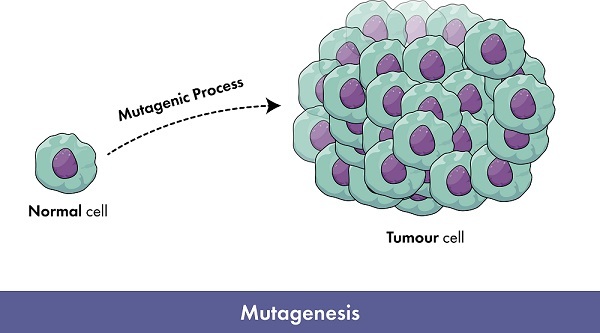
 Data Structure
Data Structure Networking
Networking RDBMS
RDBMS Operating System
Operating System Java
Java MS Excel
MS Excel iOS
iOS HTML
HTML CSS
CSS Android
Android Python
Python C Programming
C Programming C++
C++ C#
C# MongoDB
MongoDB MySQL
MySQL Javascript
Javascript PHP
PHP
- Selected Reading
- UPSC IAS Exams Notes
- Developer's Best Practices
- Questions and Answers
- Effective Resume Writing
- HR Interview Questions
- Computer Glossary
- Who is Who
What is a Mutagen and what is the Difference Between a Mutagen and a Natural Mutation?
Introduction
A mutagen is any substance or agent that causes a genetic mutation. Mutations refer to changes in the DNA sequence of an organism's genetic material, which can occur naturally or because of exposure to mutagenic agents.
Mutations are a fundamental process in evolution, and can either be beneficial, neutral, or harmful to an organism.
Mutagens are substances or agents that can increase the rate at which mutations occur. Mutagens can be physical, such as radiation, or chemical, such as certain chemicals found in tobacco smoke. In contrast, natural mutations occur spontaneously and are not caused by any external factors.

Types of Mutagens
There are several types of mutagens, including physical mutagens, chemical mutagens, and biological mutagens.
Physical Mutagens
Physical mutagens are agents that cause mutations by disrupting the DNA structure. The most common types of physical mutagens are ionizing radiation and ultraviolet radiation. Ionizing radiation can cause double strand breaks in DNA, leading to chromosomal abnormalities and mutations. Ultraviolet radiation, on the other hand, causes mutations by inducing pyrimidine dimers, which are covalent bonds between adjacent thymine or cytosine bases in DNA. These bonds can cause distortions in the DNA structure and lead to replication errors.
Chemical Mutagens
Chemical mutagens are agents that cause mutations by altering the chemical structure of DNA. They can be either natural or synthetic, and can be found in a variety of sources, including certain foods, drugs, and environmental pollutants. Chemical mutagens can be classified into two main categories: direct-acting mutagens and indirect-acting mutagens.
Direct-acting mutagens are chemicals that can directly interact with DNA and cause mutations. Examples of direct-acting mutagens include alkylating agents, such as ethyl methanesulfonate (EMS), and oxidizing agents, such as hydrogen peroxide. Indirect-acting mutagens are chemicals that require metabolic activation to become mutagenic. Examples of indirect-acting mutagens include polycyclic aromatic hydrocarbons (PAHs), which are found in tobacco smoke and some types of air pollution.
Biological Mutagens
Biological mutagens are agents that cause mutations by interacting with DNA. They can be either infectious or non-infectious. Infectious biological mutagens include certain viruses, such as human papillomavirus (HPV) and Epstein-Barr virus (EBV), which can cause mutations by integrating their DNA into the host cell's DNA. Non-infectious biological mutagens include transposons, which are DNA sequences that can move from one location to another within the genome, causing mutations in the process.
Natural Mutations
Natural mutations are mutations that occur spontaneously and are not caused by any external factors. They can occur during DNA replication or because of environmental factors, such as exposure to ultraviolet radiation or oxidative stress. Natural mutations are a normal part of the evolutionary process and can either be beneficial, neutral, or harmful to an organism.
Beneficial mutations can provide an organism with a selective advantage, such as resistance to a certain disease or a new trait that increases its fitness. Neutral mutations have no effect on an organism's fitness, while harmful mutations can reduce an organism's fitness or even lead to its death.
Difference between Mutagens and Natural Mutations
The main difference between mutagens and natural mutations is that mutagens are external agents that cause mutations, while natural mutations occur spontaneously without external factors.
Mutagens
They are external agents that cause mutations.
Can be physical, chemical, or biological.
Increase the rate at which mutations occur.
Can be harmful to an organism's fitness or health.
Are often regulated or controlled to minimize their harmful effects on humans and the environment.
Natural Mutations
Occur spontaneously without external factors.
Can occur due to DNA replication errors or environmental factors.
Occur at a baseline rate.
Can be beneficial, neutral, or harmful to an organism's fitness.
They are a normal part of the evolutionary process and can contribute to diversity and adaptation.
Overall, mutagens are external agents that can increase the rate of mutations and may have harmful effects on an organism, while natural mutations occur spontaneously and can be beneficial, neutral, or harmful to an organism's fitness. Understanding the differences between these two types of mutations is important for minimizing the harmful effects of mutagens and understanding the role of natural mutations in evolution.
Conclusion
Mutations refer to changes in the DNA sequence of an organism's genetic material, which can occur naturally or because of exposure to mutagenic agents.
Mutagens are substances or agents that can increase the rate at which mutations occur, while natural mutations occur spontaneously without external factors.
Mutagens can be physical, chemical, or biological, while natural mutations can occur due to DNA replication errors or environmental factors. Mutagens can be harmful to an organism, while natural mutations can be beneficial, neutral, or harmful to an organism.
Therefore, it is important to understand the differences between mutagens and natural mutations to minimize the harmful effects of mutagens and to better understand the evolutionary process of natural mutations.

